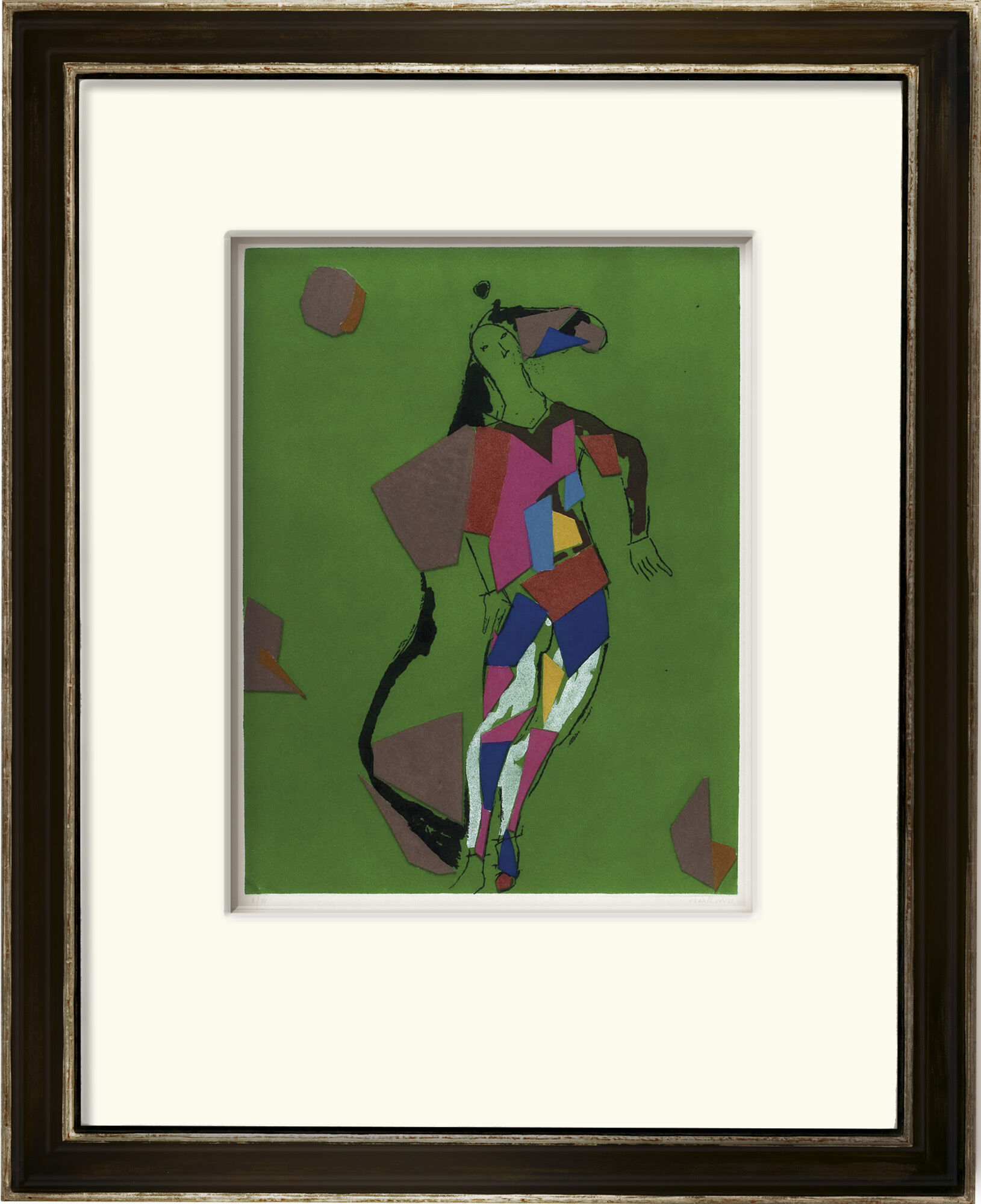Picture "Arlecchino (Harlequin)" (1974)


Picture "Arlecchino (Harlequin)" (1974)
Quick info
limited, 75 copies | numbered | signed | etching and aquatint on handmade paper | framed | size 95 x 80 cm
Detailed description
Picture "Arlecchino (Harlequin)" (1974)
Horses were among Marino Marini's favourite subjects. The artist once explained his choice of the motif by saying that his studio in Monza, where he lived in the 1930s, was located next to a horse stable. Thus, the subject would have seemed to force itself on him. The interplay and symbolism of horse and rider preoccupied Marini in his sculptures and his graphic art, whereby he formally moved in the field of tension between abstraction and figuration.
On a rich green ground, Marini shows us a dancing harlequin. The artist combines pink, violet, yellow and blue areas to create an ornamental, colourful garment. In "Arlecchino", the viewer thinks he can recognise a horse's head with a tail in the outlines of the figure.
Original etching and aquatint, 1974. 75 copies on handmade paper, numbered and signed by hand. Motif size 63 x 48.5 cm. Sheet size 83 x 69.5 cm. Size in frame 95 x 80 cm as shown.
About Marino Marini
1901-1980
The subject "horse and rider" appears repeatedly in the oeuvre of Marino Marini, who was one of the most important sculptors of Classical Modernism. The artist justified his choice of motifs by the fact that his studio in Monza, where he lived in the 1930s, was located next to a horse stable.
Whereas the studies he made in the 1930s were realistic and anatomical drawings, his sculptures and colour-intensive lithographs produced in the 1960s/70s were subject to his ever-increasing pessimism. "My equestrian statues express the torment caused by the events of this century. The restlessness of my horse grows with each new work, the rider appears increasingly worn out, he has lost his dominance over the beast and the catastrophes to which he succumbs are similar to those which destroyed Sodom and Pompeii." This also explains why the Italian artist's formal style is characterised by a tension between abstraction and figuration.
He began studying at the Academy of Fine Arts in Florence at the age of 16. When he was 28 years old, he succeeded as a professor of sculpture at the Scuola d’Arte di Villa Reale in Monza. In 1932, his great success began with his participation in the Venice Biennale. At the end of the 1940s, he achieved his international breakthrough with his famous equestrian figures.
His best-known work is probably a figure riding a horse on the terrace of the Peggy Guggenheim Collection in the Palazzo Venier dei Leoni directly along the Grand Canal in Venice. A famous story is how the former owner, Peggy Guggenheim, asked the artist to put mounting equipment on the riding figure so that it could be removed on holidays when the nuns of St. Maria della Salute passed by the palazzo in their boat.
He received many awards for his work, including the prize at the 1936 Rome Quadrennial and the Grand Prize for Sculpture at the 1952 Venice Biennale. His extensive graphic work is also represented in the world's major museums. The Marino Marini Museum, opened in Milan in 1973, pays tribute to his great life's work.
The field of graphic arts, that includes artistic representations, which are reproduced by various printing techniques.
Printmaking techniques include woodcuts, copperplate engraving, etching, lithography, serigraphy.
Collective term for the painters and sculptors of the 20th century, such as Pablo Picasso, Salvador Dalí, Joan Miró, Marc Chagall and others, whose works are the most recognized in our times.






